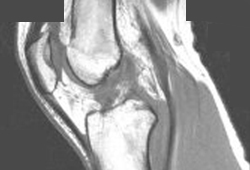Resumen
Definición
Anamnesis y examen
Principales factores de diagnóstico
- presença de fatores de risco
- estalo audível
- edema/derrame rápido no joelho
- incapacidade de retornar à atividade esportiva em andamento
- sensação de instabilidade ou curvatura do joelho
- dor
- teste de gaveta anterior positivo
- teste de Lachman positivo
- manobra do ressalto (pivot shift) positiva
Otros factores de diagnóstico
- sensibilidade no côndilo femoral lateral, platô tibial lateral
Factores de riesgo
- trauma agudo
- sexo feminino (após a puberdade)
- biomecânica
- história pregressa de lesão do ligamento cruzado anterior
- uso de travas ou chuteiras
- superfície irregular ou desigual para prática esportiva
- estado do solo/condições meteorológicas
- fadiga
- adolescentes, jovens e atletas de meia idade
Pruebas diagnósticas
Primeras pruebas diagnósticas para solicitar
- radiografias
- RNM
Algoritmo de tratamiento
todos os pacientes
Colaboradores
Autores
Philip H. Cohen, MD

Clinical Assistant Professor of Medicine
Robert Wood Johnson Medical School
University of Medicine and Dentistry of New Jersey
Piscataway
NJ
Divulgaciones
PHC has been reimbursed for travel/lodging costs and has been given a stipend for medical education lectures for MCE Conferences.
Revisores por pares
Richard Ma, MD
Gregory L. and Ann L. Hummel Distinguished Professor
Director - Division of Sports Medicine
University of Missouri School of Medicine
Columbia
MO
Divulgaciones
RM declares that he has no competing interests.
Matthew A. Tao , MD
Associate Professor
Sports Medicine and Arthroscopic Surgery
University of Nebraska Medical Center
Omaha
NE
Divulgaciones
MAT has provided consulting services to Vericel and NewClip.
Nicholas A. Trasolini, MD
Assistant Professor of Orthopaedic Surgery
Wake Forest University School of Medicine
Winston-Salem
MO
Divulgaciones
NAT declares that he has no competing interests.
Jason M. Scopp, MD
Director
Joint Preservation and Sports Medicine Institute
Peninsula Orthopaedic Associates
Salisbury
MD
Divulgaciones
JMS declares that he has no competing interests.
Jung-Ro Yoon, MD
Director
Department of Orthopedic Surgery
Seoul Veterans Hospital
Seoul
South Korea
Divulgaciones
JRY declares that she has no competing interests.
Agradecimiento de los revisores por pares
Los temas de BMJ Best Practice se actualizan de forma continua de acuerdo con los desarrollos en la evidencia y en las guías. Los revisores por pares listados aquí han revisado el contenido al menos una vez durante la historia del tema.
Divulgaciones
Las afiliaciones y divulgaciones de los revisores por pares se refieren al momento de la revisión.
Referencias
Artículos principales
Arundale AJH, Bizzini M, Dix C, et al. Exercise-based knee and anterior cruciate ligament injury prevention. J Orthop Sports Phys Ther. 2023 Jan;53(1):CPG1-34.Texto completo Resumen
American Academy of Orthopaedic Surgeons. Management of anterior cruciate ligament injuries: evidence-based clinical practice guideline. Aug 2022 [internet publication].Texto completo
Padua DA, DiStefano LJ, Hewett TE, et al. National Athletic Trainers' Association Position Statement: Prevention of Anterior Cruciate Ligament Injury. J Athl Train. 2018 Jan;53(1):5-19.Texto completo Resumen
van Melick N, van Cingel RE, Brooijmans F, et al. Evidence-based clinical practice update: practice guidelines for anterior cruciate ligament rehabilitation based on a systematic review and multidisciplinary consensus. Br J Sports Med. 2016 Dec;50(24):1506-15.Texto completo Resumen
Artículos de referencia
Una lista completa de las fuentes a las que se hace referencia en este tema está disponible para los usuarios con acceso a todo BMJ Best Practice.

Diferenciales
- Entorse do ligamento colateral medial (LCM)
- Entorse do ligamento colateral posterior
- Entorse do ligamento colateral lateral (LCL)
Más DiferencialesGuías de práctica clínica
- AAOS anterior cruciate ligament injury prevention programs: appropriate use criteria
- Exercise-based knee and anterior cruciate ligament injury prevention
Más Guías de práctica clínicaFolletos para el paciente
Lesão do ligamento cruzado anterior
Más Folletos para el pacienteInicie sesión o suscríbase para acceder a todo el BMJ Best Practice
El uso de este contenido está sujeto a nuestra cláusula de exención de responsabilidad